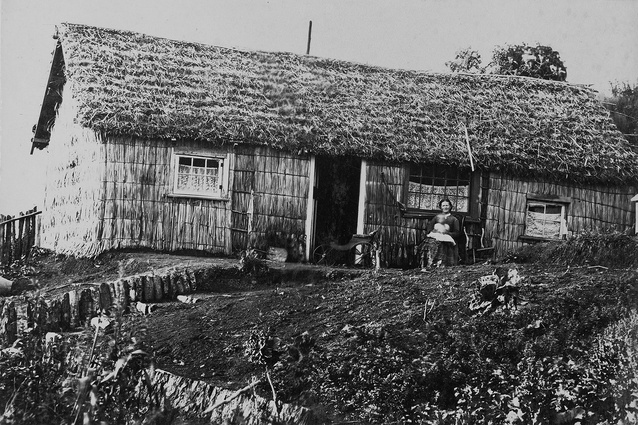Reading the raupō
Karamia Müller considers whether or not raupō architecture, long erased, might not be relics, but rather forks in the road... not artefacts, but provocations.
Reader, I’ve been thinking a lot about raupō houses lately. Specifically, hybrid architecture — the kind that used raupō as both structure and signal. So, yes… raupō houses, I guess.
Not in a nostalgic or artefact-of-the-past sense. More in that way your brain just starts, initially and gently, to sort-of obsess when you really pause to think — and, then, the noticing becomes a loop and it is full-blown Googling at 2am. I saw an image online recently: a black-and-white photograph, the architecture oblique, walls bundled with dried raupō, a gabled roof, a structure holding memory in its fibres — and I couldn’t stop… thinking. It’s a way of thinking that feels rare in a century defined by the internet’s churn. Hybrid buildings are just so completely of place that they feel both compelling and unsettling, like grief in a way — as most architecture that stays with you does.
This recent spiral began with Bhaveeka Madagammana, a doctoral researcher whose fascinating work reframes the way we read the land beneath our feet. You may have seen his recent article — and, if not, I recommend it: “Auckland was once a food garden managed by Māori — that knowledge could shape the future.” His framing landed with me (I should declare a conflict of interest here: I’m his supervisor). Yes, there are research links but, more than that, it felt like the future being opened, not closed. This is especially the case when so much of urban development feels like a race to exhaust the earth’s remaining materials under the guise of human progress — a progress that seems to leave little for what comes next.
If food gardens — conceived through a lens that respects Māori sovereignty — offer one kind of urban starting point, then surely material histories – even those long dismantled — can too. Raupō architecture, long erased, might not be relics, but rather forks in the road. Not artefacts, but provocations.
Architecture remembers laws that we have made but forget, and raupō houses weren’t just homes, they were outlawed out of existence and the urban consciousness. In 1842, the colonial government introduced an ordinance that taxed raupō houses out of existence. The official justification was fire risk. But, an argument can be made that it was more about appearances. Settler New Zealand needed to present itself as modern, stable, permanent: progressive. And raupō — signifying Māori construction, land-use and presence — stood in the way of that image. And so, raupō was removed — from towns, from memory, from architectural legitimacy. That moment mattered. And, while it has passed, we may recall it anew today. Because it wasn’t just a material being taxed. It was a world view being legislated against. The ordinance reflected a colonial logic of separation; buildings had to be fireproof, permanent and European — just as cities had to be ordered, zoned and emptied of Indigenous authority.

And so, here I am, banging away at this machine, wondering aloud: what does it mean that our urban imagination rarely includes the materials that return to earth? What might it look like to build, not for permanence but for memory, for transformation? If we indulge the proposal that architecture isn’t neutral — that it shapes who is protected and who is displaced, that it reflects whose stories are embedded into the walls and whose are pushed to the margins — then, we must also recognise its role in constructing the edge condition. Architecture as an edge condition conceptualises that those buildings, like laws, draw lines. Delineate, if you will. Between inside and out. Public and private. Us and them. We see it in zoning maps. In planning codes. In the way ‘heritage’ is preserved — whose histories are locked in place and protected, and whose are left undocumented and left to decompose. We even see it in the ways in which risk is defined. ‘Natural hazards’ often overlap with areas already socially neglected. Flood zones, erosion-prone zones, managed retreat zones – these are also the places to where people have been pushed out, again and again.
And, as severe weather increases — because of the way we’ve chewed through resources — well… reader, ‘natural’ hazards don’t feel so natural after all. The banning of raupō, I believe, was one such edge decision. It helped define who was on the inside of the colony’s future — and who had to remain outside it. But, here, I would like to consider that the edge is the most powerful place from which to design. Bhaveeka’s research, grounded in mātauranga Māori and food systems, poses a deceptively simple provocation: what if cities began with kai? What if urban design began with the knowledge of whenua, of seasonal cycles, of whakapapa? For this late-night Googler, it’s a welcome flip in thinking. It invites a material logic shaped by decay and renewal, rather than by durability and denial. In that light, raupō doesn’t look like a primitive option. It looks like part of a coherent ecological strategy — one that sees time not as linear, but as cyclical. One that knows materials will return, as they must, to the whenua. Imagine: skyscrapers designed to decompose; memorials built from materials that require human touch to maintain them; and walls that can be dismantled without harming the land beneath. In that world, sustainability stops being cyncical. It becomes a kind of life force. Polynesian culture embeds ceremony in material work. It’s tactile. It slows you down. You harvest by hand. You bind with harakeke. You weave with intention. You don’t just build a wall — you enter into relationship with it. Compare and contrast that to the ways in which buildings go up today: standardised, sometimes prefabricated, often trucked in, typically bolted on. Subcontracted labour. Imported waste.
Disconnection from place is thus baked into the very blueprint of the built realm. But materials like raupō invite something else: intimacy, acountability. You have to care for it or it falls apart. You build with the expectation of maintenance, not avoidance. And, in that, there’s a quiet lesson — every structure is temporary. Every structure is relational. I would happily take on any critic who dismisses this as romanticism. It’s not a call to upscale swamp reeds. It’s not a TED talk about sustainability. I suppose what I am saying is that, if what we build reflects what we value, then what we’ve outlawed tells us just as much. The raupō ban wasn’t about fire only. It was about refusing a world view — one grounded in Indigenous sovereignty, seasonal logic and ecological time. And, perhaps, as we begin to confront the limits of how we build — and how we imagine building — it’s time to revisit that refusal. Because it’s at the edge — of cities, of disciplines, of remembered histories — where something new might actually take root.











